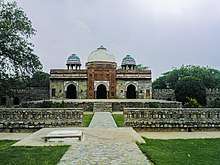Isa Khan Niazi
Isa Khan Niazi (Pashto: عیسی خان نيازي) was a Pashtun noble in the courts of Sher Shah Suri and his son Islam Shah Suri, of the Sur dynasty, who fought the Mughal Empire.
Isa Khan Niazi عیسی خان نیازي | |
|---|---|
 | |
| Born | niya zai Delhi |
| Died | 16th Century Delhi |
| Nationality | Pashtun |
| Occupation | Afghan Noble |
Biography
Isa Khan Niazi was born in 1453 and his last brother was born in 1478. He died in Delhi in 1548 at the age of 95. The time of 1451 – 1525 was the golden period for these khans. It was the time when Lodhis completely dominated the subcontinent (Hindustan). Isa Khan Niazi was a prominent member among the ruling family. He was in the same tribal unit of nobles as Ibrahim Lodhi, Sher Shah Suri. Most of these families were attached with the Delhi sultanate. There, a contention arose between Isa Khan Niazi and Sher Shah Suri which ended in mutiny.
Isa Khan's tomb complex


Tomb
Isa Khan's tomb was built during his lifetime (ca 1547-48 AD). It is situated near the site of the Mughal Emperor Humayun's Tomb complex in Delhi which was built later (between 1562-1571 AD). This octagonal tomb has distinct ornamentation in the form of canopies, glazed tiles and lattice screens, and a deep veranda surrounding it, which is supported by pillars. It stands to the south of the Bu Halima garden at the entrance of the complex. An inscription on a red sandstone slab indicates that the tomb is that of Masnad Ali Isa Khan, son of Umar Khan, the Chief chamberlain, and was built during the reign of Islam Shah Suri, son of Sher Shah, in 1547-48 A.D.[1] On 5 August 2011, restoration work on this tomb led to the discovery of India's oldest sunken garden. Isa Khan’s garden tomb is considered the earliest example of an Indian sunken garden attached to a tomb. This concept was later developed at Akbar’s Tomb and at the Taj Mahal.[2]
Mosque
At the edge of the complex, across from the tomb, lies a mosque with noticeable mihrabs. It is known as Isa Khan's Mosque. It was built at the same time as the tomb. Many of the architectural details present in these structures (such as the tomb being placed in a walled garden enclosure) can be seen evolved to a grander scale in the main Humayun's tomb.[3]
Ancestry
Isa Khan belonged to a Pashtun tribe, Niazi. His descendants are still living in Qila Niazi, Paktia Province, Afghanistan, and in Isakhel, Mianwali, Pakistan. The town of Isakhel was founded about 1830 by Ahmad Khan, ancestor of the present Khans of Isakhel, who were the acknowledged heads of the trans-Indus Niazai; and it takes its name from Isa Khan.[4][5] The municipality was created in 1875. Imran Khan Niazi, the Pakistan Prime Minister, is from the same Niazi tribe and claims descent from Haibat Khan Niazi, brother of Isa Khan Niazi.[6]
References
- World Heritage Sites - Humayun's Tomb: Tomb Complex Archaeological Survey of India (ASI).
- http://www.thehindu.com/arts/history-and-culture/article2324453.ece
- Isa Khan Niyazi Tomb Complex Archived 2007-03-11 at the Wayback Machine archnet.org.
- Isa Khel Town - Imperial Gazetteer of India, v. 13, p. 371.
- ""A Journey to the Source of the River Oxus" by John Wood". p. 57-60. Retrieved 21 September 2017.
- Catriona Luke (3 August 2018), "The enigma inside a paradox wrapped in a conundrum", The Friday Times. Retrieved 3 August 2018.
External links
![]()